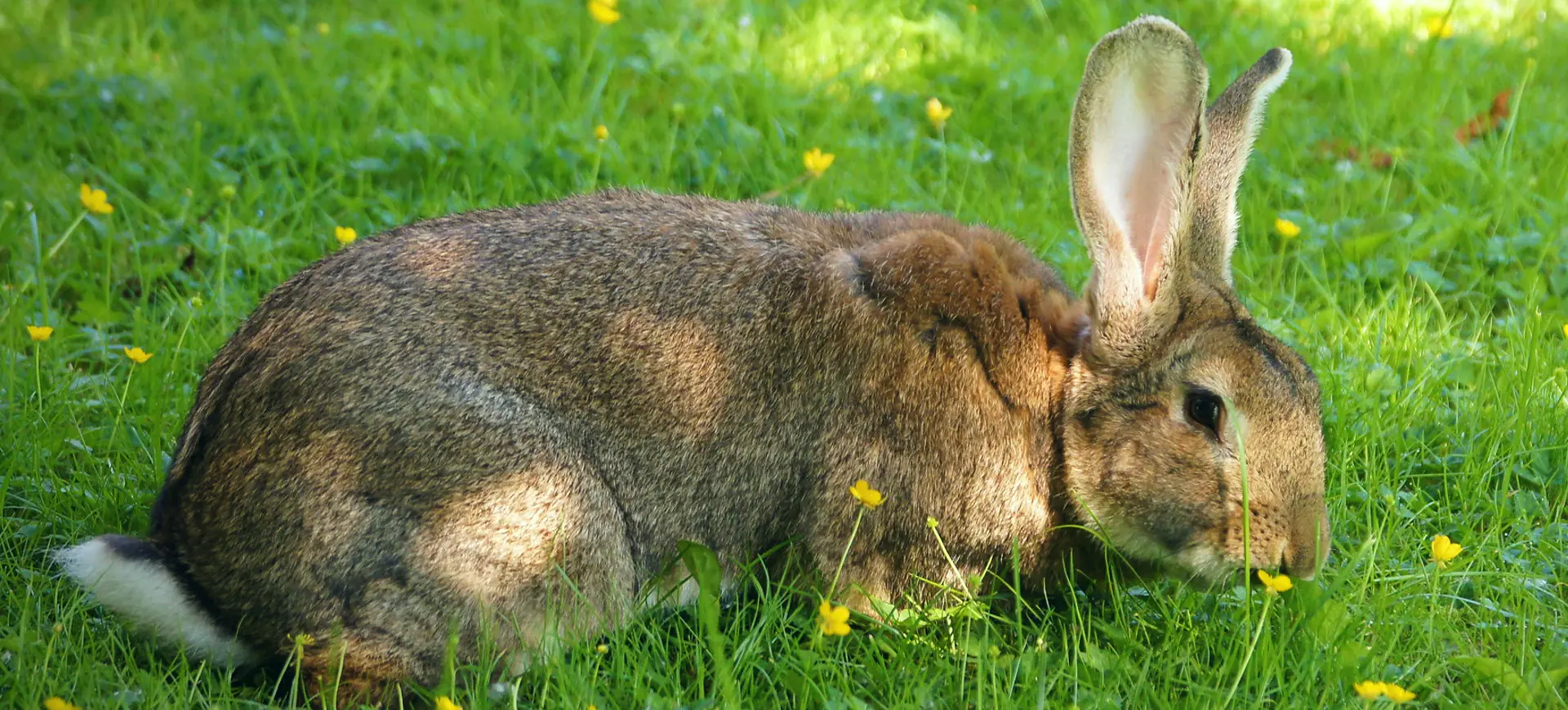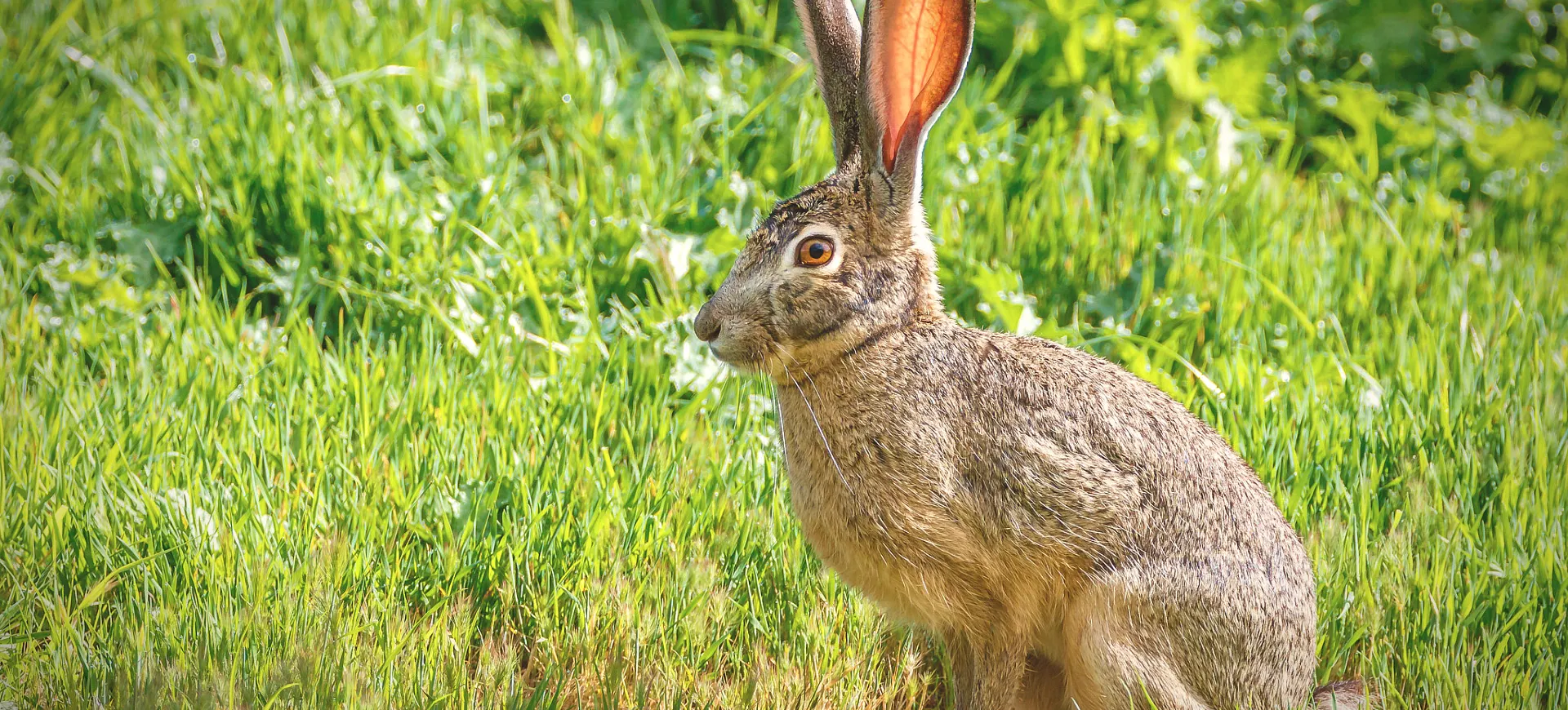Overview
The Domestic Rabbit (Oryctolagus cuniculus domesticus) is a popular pet and livestock animal descended from the European wild rabbit. These animals have been selectively bred for various traits, including size, fur type, and color, resulting in a diverse range of breeds that differ significantly in appearance and temperament. Domestic rabbits are known for their docile nature and can become closely bonded with their owners, making them suitable pets for families and individuals. They require a diet rich in hay, fresh vegetables, and a small number of pellets to maintain their health, alongside a well-maintained living environment that provides them with space to exercise and explore.
Domestic rabbits have a compact body, large hind legs, long ears, and a short tail, characteristics that vary widely among the different breeds. They are social animals that thrive on companionship from other rabbits or human interaction to prevent loneliness and behavioral issues. Regular veterinary care, including vaccinations and spaying/neutering, is essential for their well-being. Despite their gentle nature, domestic rabbits are prey animals and can become frightened easily, thus requiring gentle handling and a quiet, safe environment.
The popularity of domestic rabbits as pets has grown due to their playful nature and ability to form strong bonds with their caretakers. However, they are a significant commitment, with a lifespan ranging from 7 to 12 years, sometimes longer, depending on the breed and living conditions. Education on proper rabbit care, including diet, housing, and health maintenance, is crucial for prospective rabbit owners. Animal shelters and rabbit rescues often have domestic rabbits available for adoption, providing a responsible option for adding a rabbit to one’s family.
Taxonomy
Kingdom
Phylum
Class
Order
Family
Genus
Species
Sub Species
Type
Physical Description:
Domestic rabbits come in various sizes, colors, and coat types, reflecting the diversity of breeds within the species. The smallest breeds, like the Netherland Dwarf, can weigh as little as 2 pounds (0.9 kg), while giant breeds, such as the Flemish Giant, can exceed 20 pounds (9 kg). Their fur can range from short and sleek to long and fluffy, with colors spanning from pure white to black and many patterns. Depending on the breed, their large ears can be erect or lop (hanging down).
Male rabbits, known as bucks, tend to be slightly smaller and lighter than females, known as does, in some breeds, but this can vary. On average, bucks weigh between 2 and 11 pounds (0.9 to 5 kg) and between 2 and 12 pounds (0.9 to 5.4 kg), depending on the breed. The physical dimensions of a rabbit, including body length and ear size, can also vary widely with the breed, from the compact body and short ears of the Polish rabbit to the long body and large ears of the English Lop. These physical traits have been selectively bred over generations, resulting in the variety of domestic rabbit breeds today.

Lifespan: Captivity: ~12 Years

Weight: Male: 2-11 lbs (0.9-5 kg) || Female: 2-12 lbs (0.9-5.4 kg)

Length: Male & Female: 8-24 in (20-61 cm)

Top Speed: 35 mph (56 km/h)
Characteristic:
Native Habitat:
Domestic rabbits do not have a “native” habitat per se, as they are descendants of the European wild rabbit and have been bred in captivity for centuries. They are adapted to various indoor and outdoor environments, provided their basic needs for shelter, exercise, and safety from predators are met. Indoor rabbits can live in large cages or free-roam in rabbit-proofed rooms, while outdoor rabbits require secure enclosures to protect them from extreme weather and predators. Providing enrichment, such as toys, hiding spots, and opportunities for digging and chewing, is essential for their mental and physical health.
Whether indoors or outdoors, domestic rabbits need a clean, dry, and spacious environment that protects them from the elements and offers them a safe resting place. Bedding materials, such as straw or wood shavings, should be used to line their living areas and changed regularly to maintain hygiene. The ideal habitat for a domestic rabbit mimics aspects of their natural environment, allowing them to exhibit natural behaviors such as foraging, burrowing, and social interaction. Proper housing is a key component of rabbit care, ensuring they live a happy and healthy life under human care.
Climate Zones:
Biomes:
Biogeographical Realms:
Continents:
Countries:
Diet:
Diet & Feeding Habits:
Domestic rabbits require a diet primarily composed of high-quality hay, which provides the necessary fiber for their digestive systems and helps prevent dental problems. Fresh vegetables and herbs should be offered daily to provide essential nutrients and variety, with leafy greens being particularly important. A limited amount of commercial rabbit pellets can supplement their diet, providing concentrated nutrients. Access to clean, fresh water is essential for their health and well-being.
Treats like fruits or commercial rabbit treats should be given sparingly due to their high sugar content. Overfeeding can lead to obesity and related health issues in rabbits, making portion control and diet balance crucial. Understanding the dietary needs of domestic rabbits is important for owners, as proper nutrition is key to preventing gastrointestinal and dental issues. Regular monitoring of weight and condition can help owners adjust their rabbit’s diet as needed to ensure optimal health.
Mating Behavior:
Mating Description:
Domestic rabbits are known for their prolific breeding capabilities, with females capable of producing several litters per year. The mating process can occur quickly and does not require specific seasonal conditions, making it possible for domestic rabbits to reproduce year-round in controlled environments. Females prepare for the arrival of their young by pulling fur from their chest and abdomen to line the nest, ensuring a warm, safe environment for the kits.
The gestation period for a domestic rabbit averages 31 days, after which a litter of typically 4 to 12 kits is born. Newborn rabbits are altricial, meaning they are born hairless, blind, and dependent on their mother for warmth and nutrition. The mother rabbit nurses her kits for about 6 weeks before they are weaned onto solid food. Responsible breeding practices are essential to prevent overpopulation and ensure the mother’s and her offspring’s health and welfare.
Reproduction Season:
Birth Type:
Pregnancy Duration:
Female Name:
Male Name:
Baby Name:
Social Structure Description:
Domestic rabbits are inherently social animals requiring interaction with their kind or humans to thrive. They establish complex social hierarchies when housed in groups, engaging in various behaviors that facilitate bonding, such as grooming and playing. A solitary rabbit can become lonely and depressed, underscoring the importance of companionship for their emotional well-being. When introducing new rabbits, careful and gradual introductions are necessary to ensure compatibility and successfully integrate them into the social structure.
The bond between domestic rabbits and their human caretakers can be profound, with rabbits showing affection through nuzzling, following their owners, and seeking out interaction. Understanding the social needs of domestic rabbits is key to providing a fulfilling environment for them, whether through the companionship of another rabbit or regular interaction with humans. Behavioral issues can often be mitigated by addressing the social needs of rabbits and providing them with the companionship they crave. The social dynamics of domestic rabbits offer fascinating insights into their behavior and underscore the importance of considering their social needs in their care.
Groups:
Conservation Status:
Population Trend:
As domestic animals, the population of domestic rabbits is not tracked in the same manner as wild species. They are bred and kept by humans worldwide for pets, show, and commercial purposes. The popularity of domestic rabbits varies by region, but they are commonly found in homes, farms, and educational settings across the globe. Efforts to ensure the welfare of domestic rabbits include responsible breeding practices, proper care and husbandry, and education of potential rabbit owners.
The diversity of breeds and the widespread keeping of domestic rabbits as pets make them one of the more common domestic animals. Adoption from shelters and rescues is encouraged to provide homes for unwanted or abandoned rabbits. Population control measures, such as spaying and neutering, are important to prevent overpopulation and reduce the number of rabbits needing rescue. Advocacy for rabbit welfare, including legal protections and standards of care, continues to evolve, reflecting growing awareness of their needs as pets.
Population Threats:
The primary threats to domestic rabbits include neglect, abandonment, and improper care, often resulting from a lack of knowledge about their complex needs. Overbreeding and the pet trade can lead to surplus populations, resulting in rabbits being surrendered to shelters or released into the wild, where they are ill-equipped to survive. Predation by domestic and wild animals, exposure to harsh weather conditions, and spreading diseases, such as Myxomatosis and Rabbit Hemorrhagic Disease, pose significant risks to outdoor or improperly housed rabbits. Legal and illegal poaching for fur and meat also affects domestic rabbit populations in some areas.
Educational initiatives aimed at prospective and current rabbit owners are crucial for improving the welfare of domestic rabbits. Legislation regarding the breeding, sale, and care of domestic rabbits can help mitigate some of these threats. The promotion of adoption, along with spaying and neutering programs, can reduce the number of unwanted rabbits. Advocacy and welfare organizations play a key role in raising awareness about domestic rabbits’ needs and proper care, working towards improved welfare standards.
Conservation Efforts:
Conservation efforts for domestic rabbits focus on improving welfare standards, promoting responsible ownership, and supporting rescue and adoption initiatives. Many animal welfare organizations and rabbit rescues work tirelessly to care for abandoned or neglected rabbits, offering medical treatment, spaying/neutering, and finding permanent homes. Educational programs to inform the public about the proper care of domestic rabbits can help reduce neglect and abandonment. Advocacy for legal protections and regulations on the breeding and selling of rabbits is ongoing, aiming to ensure their humane treatment.
Collaboration between veterinarians, rabbit enthusiasts, welfare organizations, and legislators is essential for advancing rabbit welfare. Developing guidelines and resources for rabbit care, including diet, housing, and health management, supports owners in providing optimal care for their pets. International Rabbit Day, celebrated annually, highlights the importance of rabbit welfare and promotes a broader understanding of their needs. Continued efforts to improve the lives of domestic rabbits through education, advocacy, and legislation are crucial for ensuring their well-being in human care.
Additional Resources:
Fun Facts
- Domestic rabbits can learn to use a litter box, making them surprisingly tidy pets.
- They have a unique way of expressing joy, known as a “binky,” where they jump into the air and twist their body and head in opposite directions.
- Rabbits have a 360-degree field of vision, allowing them to see behind them without turning their head.
- Despite popular belief, carrots should only be given to rabbits in small amounts, as they are high in sugar.
- Rabbits can make sounds, including purring, grunting, and even screaming when distressed.
- The world’s largest rabbit breed is the Flemish Giant, which can weigh over 20 pounds (9 kg).
- Domestic rabbits have more than 50 recognized breeds, varying in size, color, and fur type.
- Rabbits have powerful hind legs and can jump up to 36 inches (91 cm) in a single bound.
- A rabbit’s teeth never stop growing, requiring constant chewing on hay and wooden toys to keep them trimmed.
- Rabbits are crepuscular, meaning they are most active during the twilight hours of dawn and dusk.








